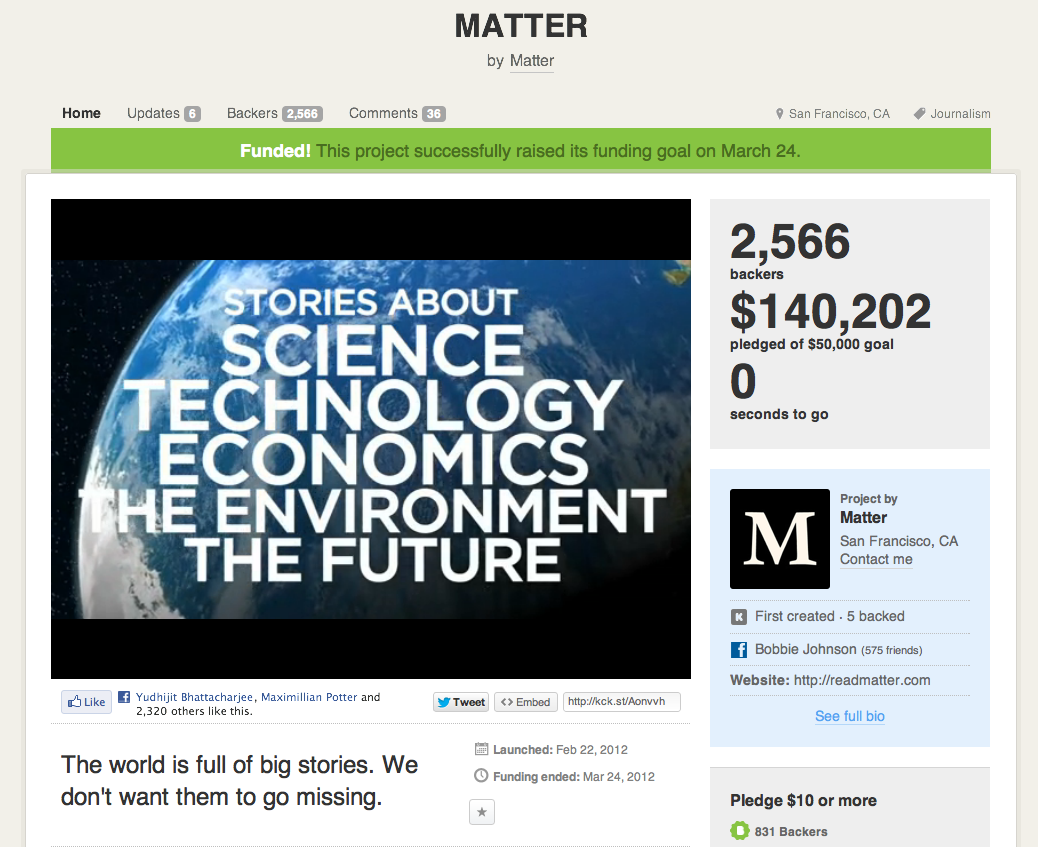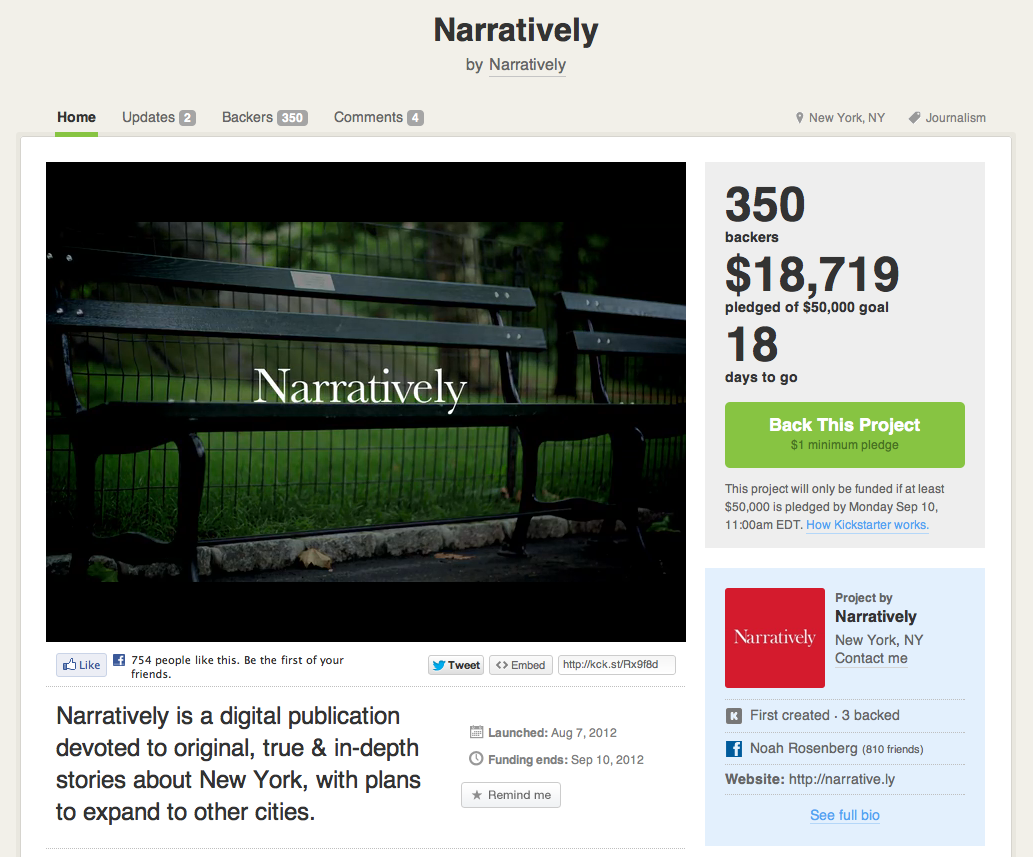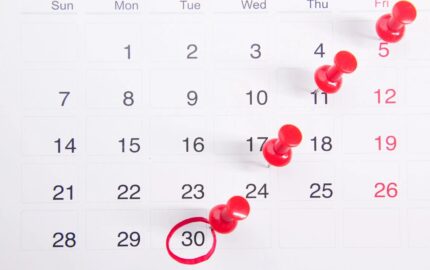Five from the field:
1. Rachel McAthy’s recent roundup of eight long-form digital projects included sites you probably already know about, like The Atavist, Byliner and Longreads, but also Matter, which recently met its Kickstarter funding goal and plans to publish one in-depth science and technology narrative per week. Learn more via Matter’s Kickstarter page:
Narratively, meanwhile, is trying to raise $50,000, also via Kickstarter, by Sept. 10, in order to launch a project devoted to New York City stories, and with a build-out plan for other cities. Backers had pledged $23,754 from 353 backers as of this morning:
2. Speaking of Kickstarter, Matt Thompson, an editorial product manager at NPR, and Center for Public Integrity board member, wrote about how the Internet is giving the “quest narrative” new journalistic relevance:
3. A nice read: Jordan Conn’s Grantland piece on Mo Isom, the former LSU goalie who’s trying to become the football team’s placekicker. A taste:
4. In one of the saddest stories about the recession, Jeff Tietz wrote about a whole population of Californians living in their cars, in a parking lot. His piece ran in Rolling Stone and featured a 56-year-old woman named Janis Adkins, who kept her “previous-life belongings” in a Yakima SpaceBooster on top of her van, which she parked in a back corner, near some avocado trees, so she could “pick their fallen fruit.” A scene where Adkins goes out begging:
5. If you hate the concept of storytelling curation, why? It’s like orchestrating a great dinner party: chemistry + content, with the possibility of drama. If you’re not already sick of the topic, we recommend Mother Jones’ list of Ayn Rand-centric must-reads. As talk of Republican vice presidential candidate Paul Ryan’s reading history continues to metastasize, Mother Jones’ Dave Gilson has culled pieces by Amy Benfer (Mother Jones), Whitaker Chambers (The National Review), Andrew Corsello (GQ), John Hodgman (New York Times magazine), Thomas Mallon (The New Yorker) and Cathy Young (Reason).
Here’s Young, writing in Reason:
And here’s Corsello, in GQ:
1. Rachel McAthy’s recent roundup of eight long-form digital projects included sites you probably already know about, like The Atavist, Byliner and Longreads, but also Matter, which recently met its Kickstarter funding goal and plans to publish one in-depth science and technology narrative per week. Learn more via Matter’s Kickstarter page:
Narratively, meanwhile, is trying to raise $50,000, also via Kickstarter, by Sept. 10, in order to launch a project devoted to New York City stories, and with a build-out plan for other cities. Backers had pledged $23,754 from 353 backers as of this morning:
2. Speaking of Kickstarter, Matt Thompson, an editorial product manager at NPR, and Center for Public Integrity board member, wrote about how the Internet is giving the “quest narrative” new journalistic relevance:
I’ve long made the case that to understand Internet time, you can’t just look at what happens every minute, with new information zooming around chaotically. You have to look at the full picture of how narratives unfold — and that can take place over months, or longer.
Kickstarter, for example, is one of the new darlings of the Internet, yet campaigns on Kickstarter take eons in our conventional understanding of Internet time. Each campaign is a quest distilled to its simplest form — a clear protagonist (the project creator) with a straightforward quest object (the amount to be funded).
The long-form journalistic quest also has its online analogue in the gradually unfolding investigation. Talking Points Memo pioneered the format online with its Polk-Award-winning U.S. attorney scandal coverage. More recently, TPM alum Paul Kiel, now at ProPublica, applied the strategy toward investigating the foreclosure crisis in the U.S. housing market. It was a classic long-form quest unfolding in real-time.
3. A nice read: Jordan Conn’s Grantland piece on Mo Isom, the former LSU goalie who’s trying to become the football team’s placekicker. A taste:
Today, she wears a baggy purple-and-gold T-shirt with knee-length Nike leggings, her hair piled atop her head. "This place is like a sanctuary for these guys," she says. "There's no way I'm walking in here in short shorts and a sports bra." When she nestles the ball under the tee, she stands up straight, her back arched and her shoulders wide. You can see why she says, with no reservation, "I'm a big girl." Right now, she says, she's a little too big. A summer in the weight room has left her with too much muscle and too little flexibility. For 22 years, she has inhabited this body, and at almost every step of the way, someone has found it to be too something. She's been called too fat and too skinny, too weak and too strong, too pretty and too ugly, too provocative and too chaste. She says, however, that none of that matters with this team. To them, she insists, it doesn't even matter that she's a woman. Just put it through the uprights, and biology will be forgotten.
4. In one of the saddest stories about the recession, Jeff Tietz wrote about a whole population of Californians living in their cars, in a parking lot. His piece ran in Rolling Stone and featured a 56-year-old woman named Janis Adkins, who kept her “previous-life belongings” in a Yakima SpaceBooster on top of her van, which she parked in a back corner, near some avocado trees, so she could “pick their fallen fruit.” A scene where Adkins goes out begging:
Adkins couldn't bring herself to look dirty. Then she remembered that after the stock market imploded, guys in business suits had walked through New York's financial district wearing sandwich boards with their résumés on them. "People read them because it's so ridiculous, it's effective," she says. So she picked a strategic thoroughfare in Santa Barbara, dressed for a job interview, and spent her last money making copies of her résumé, laminating one so that drivers could handle it without getting it dirty. She found a four-foot-tall piece of cardboard at a grocery store and wrote on it:
I'D RATHER BE WORKING
HIRE ME IF YOU HAVE A JOB
Then she stood alongside the road and held up the sign. The day was so windy it was hard to hold on to. "I was like, 'Please hire me,' and everybody's flying by, trying to ignore you, but this one guy drives up, looks at my résumé, looks at me and goes, 'Very effective. I'll take one of those.' I said, 'Thank you, I really appreciate that,' but I never heard from him. And then a homeless guy came up to me and goes, 'Wow. That ain't gonna work.' I didn't want to talk to him about it. I just wanted to stick my sign out there – I didn't have any more cardboard. And about halfway into it, I just started crying and I couldn't stop. I was so embarrassed. It was incredibly humiliating. You know how a lot of women hold their hand over their mouth when they cry? I started doing that, and that's when I raked in the money. I was sort of scared because there were so many cars that I was boxed in, and I was holding this gigantic sign and I was saying, 'I'd rather work, I'd rather you take my résumé, please help,' and I'm crying and the dollars just started coming out of the windows." But finally she cried herself out, and people stopped giving. She made $12 in three hours, all of it drawn by tears.
5. If you hate the concept of storytelling curation, why? It’s like orchestrating a great dinner party: chemistry + content, with the possibility of drama. If you’re not already sick of the topic, we recommend Mother Jones’ list of Ayn Rand-centric must-reads. As talk of Republican vice presidential candidate Paul Ryan’s reading history continues to metastasize, Mother Jones’ Dave Gilson has culled pieces by Amy Benfer (Mother Jones), Whitaker Chambers (The National Review), Andrew Corsello (GQ), John Hodgman (New York Times magazine), Thomas Mallon (The New Yorker) and Cathy Young (Reason).
Here’s Young, writing in Reason:
Reading Rand's philosophy can be an exhilarating, head-turning experience; it was for me when I first picked up her nonfiction manifesto For the New Intellectual at the age of 19, two years after coming to the United States from the Soviet Union. (Rand herself was an American immigrant from the Soviet Union, leaving her family behind to move here in 1926.) Rand's rejection of the moral code that condemns selfishness as the ultimate evil and holds up self-sacrifice as the ultimate good is a radical challenge to received wisdom, an invitation to a startlingly new way to see the world. While Rand was hardly the first philosopher to advocate an ethos of individualism, reason, and self-interest, no one formulated it as accessibly or persuasively as she did — or as passionately. In Rand's hands, the "virtue of selfishness" was not a dry, abstract rationalist construct with a bloodless "economic man" at its center. It became a bold, ardent vision of defiance, struggle, creative achievement, joy, and romantic love. That vibrancy, more than anything else, accounts for her extraordinary appeal.
And here’s Corsello, in GQ:
Goddamn, the experience of being 19 years old and reading Ayn Rand! The crystal-shivering-at-the-breaking-pitch intensity of it! Not just for that 19-year-old, but for everybody unfortunate enough to be caught in his psychic blast radius. Is "experience" even the right word for The Fountainhead and Atlas Shrugged? Ayn Rand's idolization of Mickey Spillane and cigarettes and capitalism—an experience? Her tentacular contempt for Shakespeare and Beethoven and Karl Marx and facial hair and government and "subnormal" children and the poor and the Baby Jesus and the U.N. and homosexuals and "simpering" social workers and French Impressionism and a thousand other things the flesh is heir to: experience?




